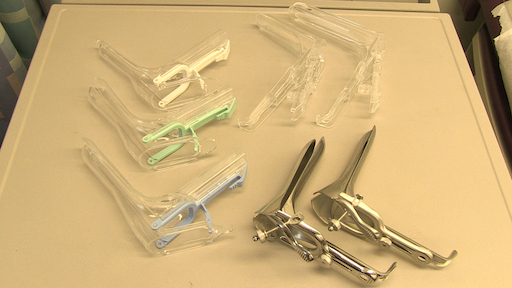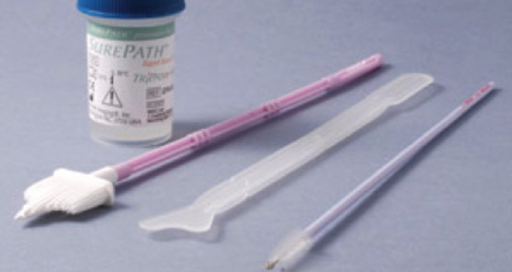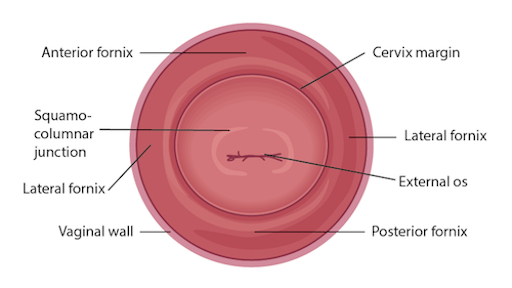内診 II: 鏡試験
English
分享
概述
ソース:
アレクサンドラ ・ ダンカン、GTA、実践臨床、ニューヘブン、CT
ティファニー ・ クック、GTA、実践臨床、ニューヘブン、CT
先週 S Talwalkar、モルドバ、内科・小児科、エール大学医学部、ニューヘブン、CT
快適な鏡の配置を提供するプロバイダー、鏡は多くの婦人科のプロシージャで必要なツールを開発するための重要なスキルです。患者とプロバイダーが鏡試験を心配している多くの場合患者の違和感なく鏡を配置することは可能です。快適な環境を作成する言語が果たす役割を認識する臨床医にとって重要です。たとえば、プロバイダーは患者の動揺を避けるために「ブレード」のではなく鏡「手形」を参照してください。
Speculums の 2 つの種類があります: 金属とプラスチック (図 1)。このデモは、プラスチック speculums は定期試験に診療所で使用される最も一般的にプラスチックを利用しています。金属鏡を使用する場合は、患者されていない場合患者は経膣的に、出産した場合墓鏡と嫌疑鏡を使用することをお勧めします。嫌疑と墓の speculums は、さまざまな形状と両方は (媒体は最も頻繁に使用されて) 多くの異なったサイズ入って来します。金属鏡を配置する前に適切な膣鏡のサイズを評価するデジタル頸部試験を実行することをお勧めします。深さと子宮頸部の方向は、膣に 1 本の指を配置することによって推定されます。患者の子宮頸部が見つかった場合、患者は座っている間、患者は浅い膣がし、したがって短い金属鏡で最も快適なはずです。

図 1。異なるサイズの市販の speculums の写真です。
プラスチック speculums、すべての嫌疑のような形は speculums を金属し、異なったサイズ入って来します。プラスチック鏡の適切なサイズを評価するために審査官はダウン、手のひら、患者さんの膣に 2 本の指を配置し、指を分離しようとしています: 小さなプラスチック製膣鏡を使用する場合は指の間にはスペースがない、指の間にスペースがある場合、いずれかのメディアを使用します。(それがかなり長くなります) としては大きな鏡と試験を実行する必要がありますは決して最初に膣に運河の長さを決定します。
鏡は、子宮頸がん検診の一環としてパパニコロー検査を実行する使用されます。子宮頸がんは、かつてはアメリカ合衆国の女性のための癌の死の一流の原因が、最近十年間にケースと死者の数が大幅に減少した1。この変更は、子宮頸がんが膣や子宮頸部細胞診によって診断される、1928 年にゲオルギオス ・ パパニコロウ製発見に入金されます。Pap テストが今呼ばれる、子宮頸部癌と前癌の異常な細胞を検出します。スクリーニングの推奨間隔の現在のガイドラインは、米国予防サービスのタスクフォース (USPSTF) web サイト2を見つけることができます。
いずれか 1) の従来のガラス スライドを使用してテストを実行することができ、ヘラと子宮頸管ブラシ (、伝統的な「パパニコロウ塗抹」) や 2) より頻繁に定着剤利用液状細胞診子宮頸部ほうき又はヘラと子宮頸管ブラシ (図 2)。どんなにどのようなツールを使用すると、サンプルは、外部 os や扁平円柱上皮接合部 (図 3) os 周りの遷移帯のすぐ内側から収集されます。このビデオで説明ヘラ液体製剤としての液状細胞診による子宮頸管ブラシは子宮頸部病変の検出のためのより効果的な手法とヘラと子宮頸管ブラシ改善標本コレクション。

図 2。パップスメア ツール。順序で示されている: 液細胞診キャニスター、頸部ほうき、ヘラ、および子宮頸管ブラシ。

図 3。子宮の図ラベル関連構造。
Procedure
Applications and Summary
This video reviewed the techniques for performing a comfortable speculum exam and collecting the samples for a Pap test. Before the exam is started, the examiner should ensure all supplies are prepared and let the patient know what to expect. Being able to perform a comfortable speculum exam is an important skill for any practitioner, as it is used in a wide variety of gynecological procedures and can provide a wealth of information. When the speculum is inserted, it is possible to observe the cervix and vaginal walls for a variety of signs including tone, color, discharge, lesions, polyps, ulcerations, and more-all of which may be clinically significant and can help with the process of diagnosis. A well-inserted speculum also allows easy access to the cervical os, at which point samples may be taken for the Pap test (as well as for other screenings, like chlamydia and gonorrhea). It's necessary to use a speculum to access the cervix for many other procedures, including inserting or removing an intrauterine device (IUD), a loop electrosurgical excision procedure (LEEP), and more.
Many patients may feel anxiety about the speculum and experience it as the most invasive part of the gynecological exam. The provider can offer the patient general support and empathy, along with specific tools to make the exam more comfortable for themselves. Asking the patient to take a deep breath and then bear down as if having a bowel movement before insertion can open the vaginal introitus and greatly aid comfort. The examiner may offer a particularly anxious patient the opportunity to insert the speculum themselves by placing it upside-down with the handle pointing toward the ceiling as the provider talks them through opening it3. It is often easier to get a clear view of the cervix with an upside-down insertion, but it is not a technique practitioners should employ, because it places the examiner's hand directly against the patient's clitoris.
There are many things the practitioner can do to ensure the exam is comfortable. The speculum should be inserted at an oblique angle to avoid putting too much direct pressure on the urethra. When the speculum is inserted fully, the bills should be angled below where the cervix was located during the digital exam. The practitioner can then apply enough posterior pressure to the speculum, so there is space visible in the vagina over the bills; this allows the bills to be opened without putting pressure on the delicate anterior structures. The most important thing is to never insert or remove a speculum while the bills are open. This is very painful and risks injuring the patient. The examiner should not touch the thumb lever until the speculum is positioned fully and ready to be opened. The lock on the speculum should be released fully before removal, and any pressure maintained manually. Once the cervix is free, the thumb lever should be completely released and the speculum smoothly removed the rest of the way, allowing the vaginal walls to close the bills on the way out.
References
- Cervical Cancer Statistics. U.S. Preventive Services Task Force. Centers for Disease Control and Prevention (2014).
- Cervical Cancer: Screening. Recommendation Summary. U.S. Preventive Services Task Force (2012).
- Wright, D., Fenwick, J., Stephenson, P., Monterosso, L. Speculum 'self-insertion': a pilot study. Journal of Clinical Nursing. 14(9): 1098-1111 (2005).
成績單
The speculum exam is used in a wide variety of gynecological procedures and can provide a wealth of diagnostic information. The speculum is a bivalve instrument, which is utilized for separating the walls of the vaginal canal. This not only allows for visual inspection of the cervix, but also provides an access to this region for specimen collection during diagnostic procedures such as the Papanicolau, or Pap test, which is performed to check for any precancerous changes. This video will illustrate the proper technique of using the speculum for cervical inspection, and the appropriate method for collection of samples for the Pap test.
Let’s begin with the review of the steps involved in prepping for the speculum exam and the Pap test, followed by a discussion of what a physician should look for while inspecting the cervix through the speculum. There are different types of commercially available specula. Some are made up of disposable plastic, while the metal ones are reusable. In this demonstration, we will use a plastic speculum.
Before starting the exam, it is essential to familiarize yourself with the instrument to be used and understand how it functions. After that you shall begin with the exam. Remember, this procedure usually comes after the external pelvic inspection, so at this point the patient history has been obtained, and they are already in the modified lithotomy position.
Make sure that the patient is seated at the end of the table to allow compete insertion of the speculum. Also lay out the supplies for the Pap test, including a cytology canister; lubricant squeezed onto a clean tray with a liner, and a spatula and endocervical brush OR just a cervical broom to collect the cell sample.Label the liquid cytology canister with the patient’s information. Then unscrew the lid of the canister until it is resting on top such that it can be easily lifted off.
It is essential to understand how to hold a speculum. In case you’re using a plastic speculum, place it in your non-dominant hand and position your index finger above the bills, your middle finger below the bills, and your thumb on the back of the speculum, avoiding the thumb lever as that would open the speculum. Using your dominant hand spread the water-based lubricant on the outside of the bills. Show the speculum to the patient without pointing it directly at them, and let them know what to expect during the exam, “Dialogue”.
Start by letting the patient know that you will first place the back of your hand on their thigh. This is done to prepare the patient for the exam by establishing a non-invasive contact first. Now separate the labia minora with the dominant index and middle finger pads to get a clear view of the vaginal introitus. Next, explain the relaxation technique to the patient, “Dialogue”. The vaginal introitus should open up as the patient bears down. Let the patient know that you are about to insert the speculum, “Dialogue” and place it halfway into the vaginal canal, keeping the bills at about 45° angle. Next, bring your non-dominant hand to the bottom handle and rotate the speculum flat, while simultaneously clearing the labia on both sides. Then angle the tip of the bills toward the floor and insert fully, such that the tip ends up below the cervix. Stop when the speculum is flushed against the patient’s pelvis.
Next place one of the dominant fingers inside the bills and apply strong posterior pressure while pulling down on the handle with the other hand until it is perpendicular to the floor. Make sure you apply enough pressure to see the space above the speculum. Now, while maintaining posterior pressure with the finger inside the speculum, you can smoothly depress the thumb lever to open the bills. Stop once resistance is met. Then engage the lock by pushing the thumb lever up one or two clicks and remove the finger from inside the speculum. Hold the speculum steady and, using a light source, check if the cervix is visible. Note the tone, color, and position of the cervix and observe for discharge, lesions, polyps, ulcerations, and masses.
You can visually inspect the lower intravaginal part of the cervix. This includes the exocervix, which is normally 2-3 cm in diameter, pink in color, and has a smooth surface; the external os, which is the opening of the endocervix into the vagina; and the four fornices, which are the recesses between the cervix margin and the vaginal wall.
After the visual inspection of the cervix, proceed to collecting samples for the Pap test. With the speculum still in place, insert the spatula into the vagina, being careful not to touch the walls. Position the spatula with its long end in the os, and the short end pressed against the junction. Now rotate it 360°, while maintaining consistent pressure and contact with the exocervix. Carefully remove the spatula avoiding the vaginal walls. Place the spatula into the open cytology canister and thoroughly rinse it by vigorous swirling in the liquid following the manufacturer’s instructions. Next, insert the endocervical brush into the vagina avoiding contact with the walls. Push the brush into the os until only the bottom bristles are exposed and then slowly rotate it 180° in one direction. Do not over rotate. Carefully remove the brush avoiding the walls, and place it into the cytology canister. Thoroughly rinse the brush by vigorous swirling and press it repeatedly against the sides of the canister to release material. Instead of using both spatula and brush, one can use just the endocervical broom, which has different sizes of bristles forming a triangular pattern. If using this, then you would insert it so the longer bristles rest in the os and the shorter rest on the transition zone and rotate it about five to ten times, depending on manufacturer’s instructions. The release of the sample is same as for that for the endocervical brush.
After sample collection is complete, release the locking mechanism by pressing down on the thumb lever, and while holding the lever down and bills open, remove the speculum about two to three inches out, to ensure that the cervix is cleared off the tip of the bills. Remove your thumb from the lever and place it on the handle. Finally, rotate the speculum by 45° while smoothly removing it all the way out. Have your hand underneath the speculum to catch any possible discharge, and discard the speculum, if disposable. At the end, replace the canister lid. Now the sample is ready for subsequent cytological analysis.
“Examiner explaining different types of specula-the similarities and differences”
You’ve just watched JoVE’s illustration of the speculum exam and the Pap test. You should now understand how to use the vaginal speculum and how to collect cervical cell sample for diagnostic evaluation. As always, thanks for watching!
